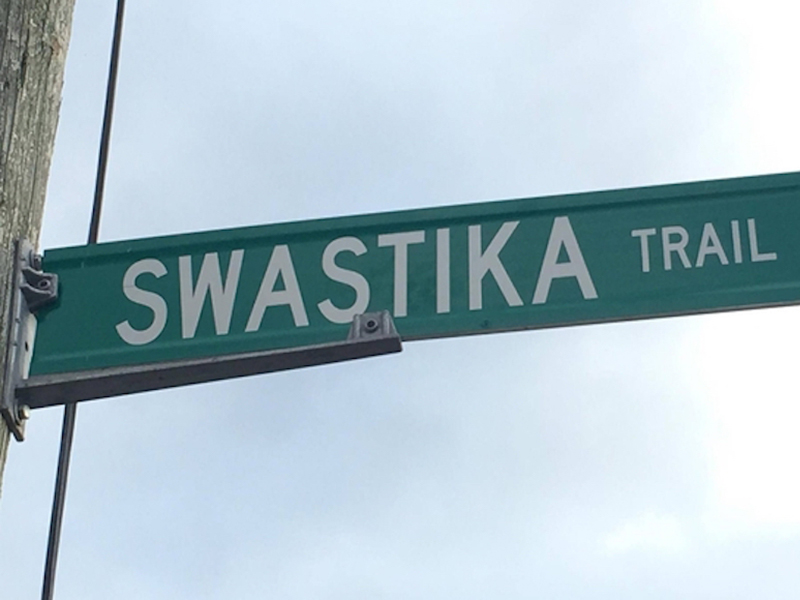A court has ruled that an Ontario town acted within the rules when it decided to keep the controversial name of a local road.
In a ruling that was released this month, a three-judge panel of Ontario’s Superior Court of Justice rejected an application for a judicial review of a Puslinch town council decision to keep the name Swastika Trail.
“There is no doubt that to many people in Canada in the 21st century, the swastika is an abhorrent symbol, reminiscent of the atrocities perpetrated by the Nazis during World War II,” the judges wrote in a 14-page ruling.
While the council’s decision “likely does not accord with the beliefs of many Canadians,” it acted lawfully when it voted to keep the name of the private road, the ruling stated.
There are about 54 residents on Swastika Trail, a short stretch of road near Puslinch Lake, which is just east of Cambridge, Ont.
The matter goes back to 2017, when residents raised concerns over the street’s name. Some said it was confusing because of how it intersected with other roads, while others said it was offensive, as the name is associated with hate and genocide.
Those wanting the status quo argued that the road was named in the 1920s, when the swastika was not associated with the Nazis, that there would be a significant cost and inconvenience to changing the addresses on residents’ pieces of identification and that the issue was dividing the community.
The council commissioned a report from town staff and then asked the Bayview Cottagers’ Association, which includes residents who live on Swastika Trail, to put the matter to a vote. In November 2017, the association voted 25-20 to keep the name. A month later, the council voted 4-1 to retain the name.
That led two area residents, Randy Guzar, who lives on Swastika Trail, and William Knetsch, who lives in Puslinch but not on the road, to take the matter to court, alleging the township “deferred entirely” to the results of the residents’ vote, which was “flawed, procedurally unfair and unreliable.”
READ: CANADIAN’S TEMPLE MOUNT PHOTO LEADS TO DEATH THREATS
The town council, they claimed at a hearing in April, “exercised no independent judgment with respect to Swastika Trail’s name.”
The court disagreed, saying town councillors did not base their decision exclusively on the cottage association’s vote, “but were influenced by a number of factors.” The court also found that council “did not unlawfully sub-delegate its decision-making power.”
Even though it dismissed the claim, the court noted the objections to the modern meaning of the swastika, which was an ancient symbol of wellbeing and good fortune before it was co-opted by the Nazis.
Both Guzar and Knetsch asserted that the swastika “is a symbol that has represented hatred, white supremacy and anti-Semitism since World War II in Canada and elsewhere in the world,” according to the judgment.
Guzar’s father fought in the Second World War and he believes the swastika “remains a symbol used to promote white supremacy and anti-Semitism.”
Guzar said that when he presents his driver’s licence or health card, “he is routinely asked if he is a white supremacist or a neo-Nazi,” the judgment noted.
Knetsch, whose parents lived in Holland during the Nazi occupation, “finds the swastika to be deeply offensive, upsetting and disturbing,” the judges acknowledged.
“He does not want to be associated with the symbol, and does not believe that Canadian society should accept the swastika as an appropriate name for a publicly accessible road.”
Swastika Trail is owned by a private corporation controlled by Paul Wyszynski, who owns a home on the road,.
“Our trail has nothing to do with Hitler,” his wife, Lori Wyszynski, has previously said. “It’s nothing to be ashamed about.”
B’nai Brith Canada, which compiled a 2,000-name petition urging a name change, said it was disappointed by the court ruling.
Spokesperson Marty York noted that the court acknowledged that Canadians regard the swastika as “an abhorrent symbol.”
“The door is still open for Puslinch to do the right thing and erase this emblem of evil from the map of Canada,” York said.
According to William L. Shirer’s The Rise and Fall of the Third Reich, Adolf Hitler, a frustrated artist, personally chose the swastika as the nascent Nazi party’s symbol in 1920.
